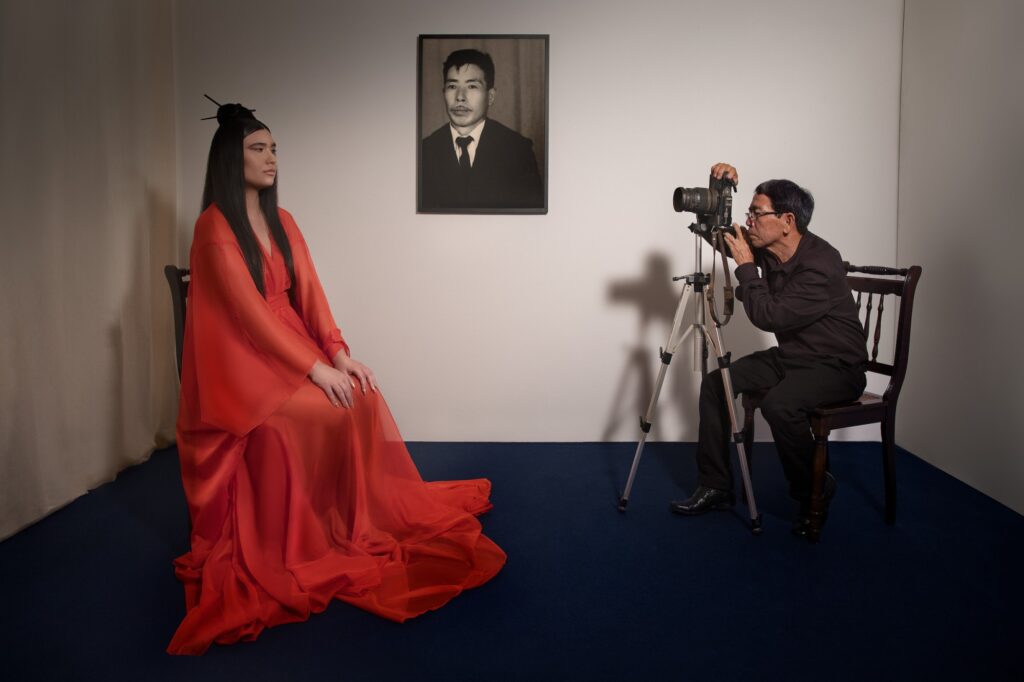
The concept of diaspora has always been complex, encompassing notions of migration, identity, displacement, and belonging. The experiences of people within diasporic communities often reflect a delicate balance between maintaining cultural heritage and adapting to new, sometimes unfamiliar, environments. Asian communities in Latin America and the Caribbean embody this intricate process, and the exhibition “Halfway Out: Asian Artists in Latin America and the Caribbean”, recently displayed at the Americas Society in New York, provides a rare and insightful glimpse into this experience. The exhibition succeeds in showcasing art by Asian artists in these regions without falling into the trap of essentializing their identities, instead highlighting the fluidity of cultural exchanges and the multifaceted nature of identity.
Curated with a thoughtful approach that resists reductive interpretations, Halfway Out offers a nuanced exploration of the Asian diaspora, examining how these artists navigate multiple cultural landscapes and histories. Rather than focusing solely on the artists’ Asian heritage as a singular defining characteristic, the exhibition considers how their art reflects broader societal and cultural forces. By doing so, the exhibition raises important questions about how identity is constructed and expressed, and how migration shapes artistic practices.
Decentering Essentialism: A Delicate Balance
One of the exhibition’s most notable strengths is its refusal to essentialize the identities of the artists on display. It would be all too easy for an exhibition about Asian artists in Latin America and the Caribbean to fall into the trap of presenting these artists as representatives of a homogenous “Asian” experience. However, “Halfway Out” carefully avoids this pitfall, choosing instead to highlight the diversity of experiences and artistic approaches within this group.
The term “Asian diaspora” encompasses a vast range of cultural, ethnic, and national identities, and the exhibition acknowledges this diversity rather than reducing it to a single narrative. Artists of Chinese, Japanese, Korean, and Indian descent are featured, each with their own unique experiences of migration and cultural exchange. The works displayed reflect this diversity, ranging from abstract installations to more figurative pieces that engage directly with questions of history and memory. By presenting a wide array of artistic practices, the exhibition emphasizes that there is no singular “Asian” perspective, but rather a multiplicity of viewpoints informed by a variety of experiences.
For instance, the work of artist Claudia Coca, who has Chinese and Peruvian heritage, addresses issues of identity and belonging by interrogating the colonial past of Peru and the complex legacy of Chinese immigration to the region. Her installations combine elements of traditional Chinese iconography with references to Peru’s indigenous cultures, reflecting the hybrid nature of her own identity. By juxtaposing these different cultural symbols, Coca challenges viewers to reconsider the ways in which cultural identities are constructed and negotiated in post-colonial contexts.
Similarly, Japanese-Brazilian artist Kazuo Okubo’s work explores the intersection of his Japanese heritage and Brazilian upbringing. Rather than presenting his identity as fixed or static, Okubo’s abstract paintings and sculptures evoke the dynamic interplay between his Japanese ancestry and the Brazilian cultural environment in which he was raised. Through fluid shapes and bright, vibrant colors, Okubo’s work reflects the blending of cultural influences, underscoring the idea that identity is not monolithic but rather constantly in flux.
Migration as Transformation: The Fluidity of Identity
At the heart of “Halfway Out” is the concept of migration as a transformative process that reshapes identities and artistic practices. The exhibition highlights how the act of migration—whether voluntary or forced—inevitably leads to a reconfiguration of identity, as individuals are exposed to new cultural, social, and political contexts. This transformation is evident in the works on display, many of which reflect a sense of dislocation, hybridity, and cultural negotiation.
Artist Nicola López, of Mexican and Korean descent, provides a striking example of this transformation. Her work, which includes large-scale prints and mixed-media installations, grapples with themes of displacement and the impact of migration on the urban landscape. López’s intricate depictions of cities in flux—full of fragmented structures and tangled networks of roads—serve as metaphors for the experience of migration itself. Her work captures the disorienting feeling of being caught between multiple cultures and places, while also reflecting the possibility of creating new forms of identity and belonging in the midst of these shifting landscapes.
Similarly, the work of Trinidadian artist Wendy Nanan engages with questions of migration and identity in the context of the Caribbean, a region deeply shaped by the legacies of colonialism and the transatlantic slave trade. Nanan’s sculptures and prints often incorporate elements of both Asian and African diasporic cultures, reflecting the complex intersections of race, ethnicity, and migration in the Caribbean. By bringing together these different cultural references, Nanan’s work challenges the binary notion of identity as either/or, instead proposing a more fluid understanding of identity as both/and.
The fluidity of identity is further emphasized by the exhibition’s title, “Halfway Out”, which suggests a state of being neither fully here nor fully there. This notion of being “halfway out” resonates with the experience of many diasporic communities, who often feel a sense of in-betweenness, caught between their ancestral homeland and their new place of residence. Rather than presenting this in-betweenness as a source of confusion or loss, however, the exhibition celebrates it as a source of creative potential. The works on display reveal how artists use their in-betweenness to explore new ways of thinking about identity, belonging, and the relationship between past and present.
Art as a Bridge Between Cultures
In addition to exploring themes of migration and identity, “Halfway Out” also highlights the role of art as a bridge between cultures. The works on display demonstrate how artists draw on their diverse cultural backgrounds to create art that speaks to both local and global audiences. By incorporating elements of both Asian and Latin American or Caribbean cultures, these artists create works that transcend national and ethnic boundaries, forging connections across cultures.
For example, the work of Cuban artist Flora Fong combines traditional Chinese calligraphy with Cuban landscapes, creating a dialogue between two seemingly disparate cultural traditions. Her vibrant paintings, which often depict Cuban tropical plants alongside Chinese characters, reflect her own experience of growing up in a Chinese-Cuban household. Through her art, Fong creates a bridge between her Chinese heritage and her Cuban upbringing, reflecting the interconnectedness of these two cultures.
Similarly, Brazilian artist Tomie Ohtake, of Japanese descent, creates abstract sculptures that reflect both the simplicity of Japanese aesthetics and the boldness of Brazilian modernism. Ohtake’s work, which often incorporates flowing lines and organic shapes, speaks to the influence of both Japanese and Brazilian artistic traditions. By blending these different influences, Ohtake’s sculptures transcend national boundaries, offering a visual representation of the global nature of the Asian diaspora.
An Exhibition of Complexity and Depth
“Halfway Out” succeeds in presenting a complex and nuanced view of the Asian diaspora in Latin America and the Caribbean. By avoiding the pitfalls of essentialism, the exhibition offers a diverse range of artistic practices that reflect the multiplicity of experiences within these communities. The works on display highlight the fluidity of identity, the transformative nature of migration, and the power of art to bridge cultures.
In a time when conversations about identity are often polarized and reductive, “Halfway Out” offers a refreshing reminder of the complexity of human experience. The exhibition celebrates the diversity of the Asian diaspora without reducing it to a single narrative, instead emphasizing the richness of cultural exchange and the creative possibilities that emerge from the intersections of multiple identities. Through its thoughtful curation and wide-ranging artistic approaches, “Halfway Out” offers a powerful and thought-provoking reflection on the nature of identity in a globalized world.
No comments yet.








